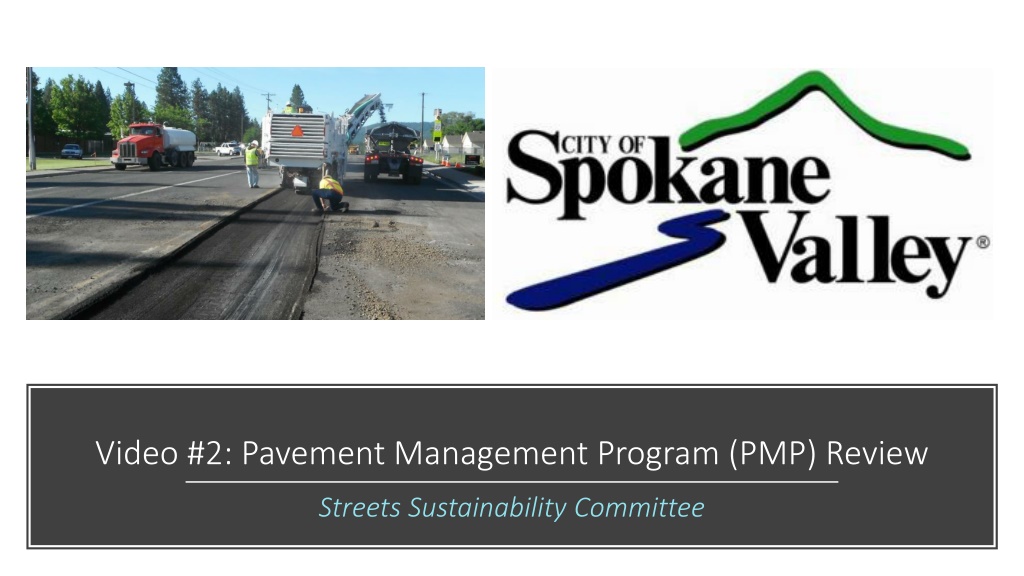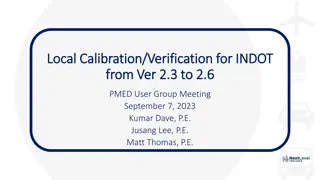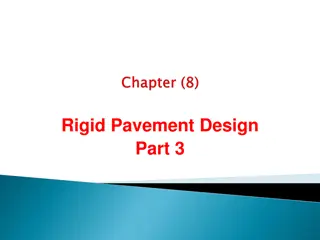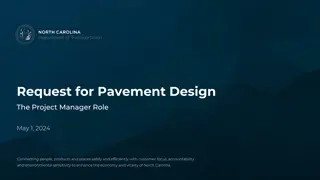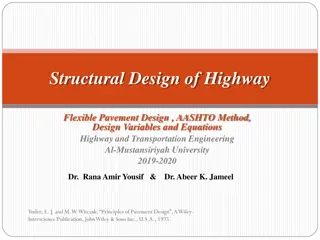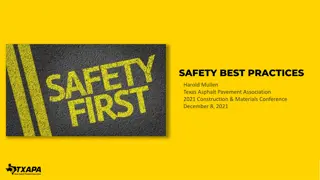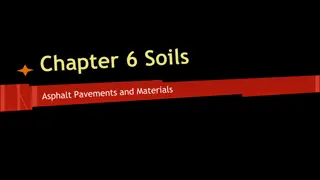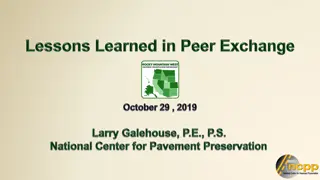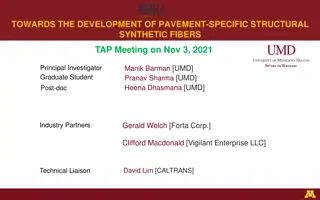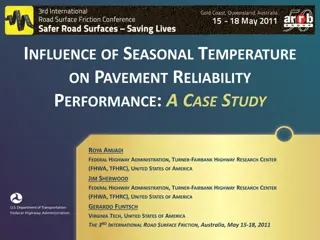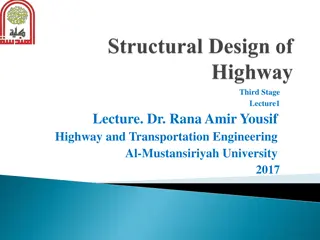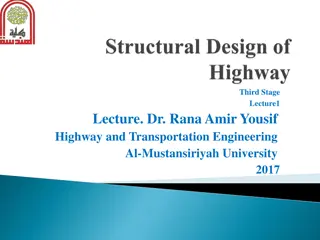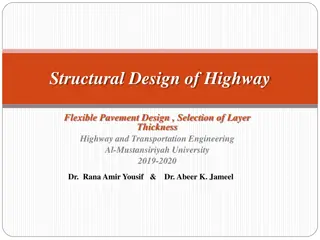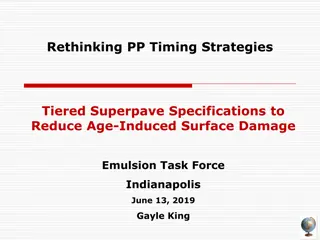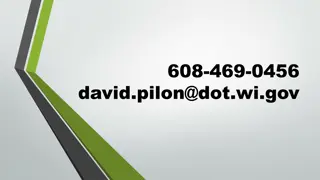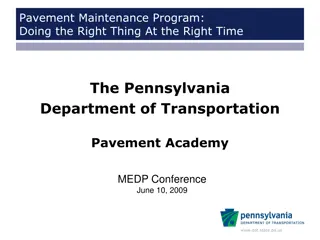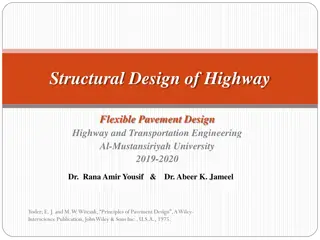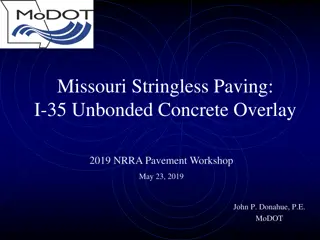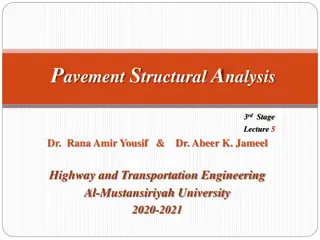Understanding Pavement Management Programs: A Comprehensive Overview
Discover the intricacies of a Pavement Management Program (PMP) through a detailed review presented to the Streets Sustainability Committee. Explore the historical practices, recent advancements, and key elements of the City's PMP. Learn about 450 centerline miles, street classifications, budget considerations, and the principles of cost-effective pavement management to extend road lifespan while optimizing resources.
Download Presentation

Please find below an Image/Link to download the presentation.
The content on the website is provided AS IS for your information and personal use only. It may not be sold, licensed, or shared on other websites without obtaining consent from the author. Download presentation by click this link. If you encounter any issues during the download, it is possible that the publisher has removed the file from their server.
E N D
Presentation Transcript
Video #2: Pavement Management Program (PMP) Review Streets Sustainability Committee
Video Overview Introduce Review Review Introduce the City s PMP Review historical practices of the City s PMP Review recent improvements to the City s PMP Discuss the elements of the PMP 2019 3rd-party review outcomes Pavement condition data process Distinguish between preservation and maintenance
450 centerline miles 128 Arterial/Collectors 322 Local Access streets 1,000 total lane miles 1,900 acres of paved streets (8% of total City area) Four Street Classifications: Principal Arterial Minor Arterial Collectors Local Access What makes up the City s paved street network?
What makes up the Citys paved street network? What s the difference between Arterials/Collectors and Local Access? Principal Arterial 968,930 11% Minor Arterial 1,406,316 15% Local Access 6,150,455 67% Collector 670,842 7% Paved Area (square yards)
City Objectives, Policies & Budgets How should we care for our most expensive asset? Balanced Balanced Approach Approach Priorities, Analysis Techniques & Reporting Understanding of Condition
Part I: What is a Pavement Management Program? 6
What are the basic principles of pavement management? COST EFFECTIVE MAXIMIZE RESOURCES KEEP ROADS IN BETTER CONDITION FOR A LONGER TIME AT A LOWER COST
Pavement Life Cycle Curve Pavement Quality Target Zone for Pavement Rehabilitation Increased Pavement Life 40% of pavement life Excellent Time has a 15% drop in quality Very Good 15% of pavement life Pavement Quality $1 spent now Good has a 40% drop in quality What are the basic principles of pavement management? Fair Poor Costs $8 if delayed Very Poor Time
So how does the PMP function in Spokane Valley?
Preservation The street surface you actually drive on Seals, overlays, reconstruction Planning for extending the life of the pavement Two primary functions of the Pavement Management Program Maintenance Everything else to make the street system work Snow plowing, pothole repair, crack filling, signal and sign repair, street sweeping, sidewalk repair Annual plans for system maintenance needed now
Preservation Annual preservation costs $10 million What does the PMP cost? What does the PMP cost? $16 million/year to keep the overall system in its existing good condition (this is not what we actually spend) Maintenance Annual maintenance costs $6 million
Preservation Value is based on a projection of future project costs needed for the paved streets to remain in their current condition How is this cost calculated? Maintenance Value is based on historical costs for City to provide current level of service
Preservation $10 M annually to keep pavement as-is $5 M actual expended (historical avg.: $3 M local + $2 M grants) $5 M annual shortfall (Not covered. Services are reduced) What services are provided? Annual overlay and reconstruction projects Pavement is aging faster than we can preserve it. Reduced services includes: Fewer projects Fewer treatment methods $5 M/Yr is applied to asphalt preservation How does the community value these services? Maintenance $6 M annually to maintain existing services $3 M dedicated funds $3 M annual shortfall (covered by reserve transfers) What services are provided? Snow and ice control Pavement repairs: potholes, patches, crack fill, sidewalks Traffic signals and signs Street lighting Street sweeping & vegetation control $1M/Yr is applied to asphalt maintenance
$8 M annually budgeted to the Pavement Management Program How does the community value these services? -16 M annual cost to maintain paved street network (Good PCI of 76) = $8 M funding shortfall Increase PMP budget to keep our roads in their current condition, OR Reduce services to fit within available budget.
The Citys PMP Funding Roadmap Incorporation 2004 2006/2007 City conducts its 1st condition survey-Street Master Plan 2008 2011 2003 Proposed utility tax discussion does not move forward Telephone utility tax approved and effective in 2009 Preservation Fund #311 created 2012 2013 2014 2016 2011 PMP adopted & General Fund transfers used for preservation Projects Civic Facility Replacement Fund #123 transfers $2.3 Million into Fund #311 over 4 years Council sets goal for a sustainable PMP (recurring thru 2021) Proposed utility tax discussion does not move forward 2020 2018 2019 2021 2019 condition survey results, action items, & improvements 3rd Party PMP review, New survey contract Solid Waste Collection Fee for Local Access streets Streets Sustainability Committee
Overall, the Citys PMP is satisfactory, but improvements were suggested: Improve software capabilities and data collection frequency How did the 2019 3rd-party review affect where we are today? Identify pavement condition targets Identify revenue to achieve targets Engage the community
How have City surveys progressed over time?
City Surveys Pavement condition assessments every 2-3 years since 2006 Incremental improvements over time Manual/walking (2007, 2009) Improved condition assessments Consistent, reliable Semi-automated (2011, 2013, 2016, 2018) Improved software User-friendly Fully-automated (2019)
What is a pavement condition survey?
Pavement Condition Survey Survey 100% of City streets every 3 years Arterials & Collectors get two passes Local Access streets get one pass StreetScan collects & computes road condition
How does the City measure up?
PCI: Pavement Condition Index PCI: Pavement Condition Index Network average score: 76 79 77 76 74
How can we plan for preservation?
PMP Software: Software supports decision making Scenario & budget planning Plan for a target PCI Get the applicable budget as a result Plan for a target budget Get the applicable PCI as a result Set priorities by: Street functional class Asphalt repair type Number of years Location
How do costs impact the setting of your Pavement Condition Target? More $$$ Preservation: $10 Mil/Yr Maintenance: $6 Mil/Yr Total: $16 Mil/Yr Should we use surface treatments on our streets? Less $
What long-term pavement condition should we plan for? Which type of pavement repairs are acceptable? Key Considerations Which program services should be prioritized?
Streets Sustainability Committee For more information: https://www.spokanevalley.org/StreetsCommittee Adam Jackson, Pavement Management Program Coordinator 509-720-5024 Ajackson@SpokaneValley.org StreetSolutions@SpokaneValley.org
